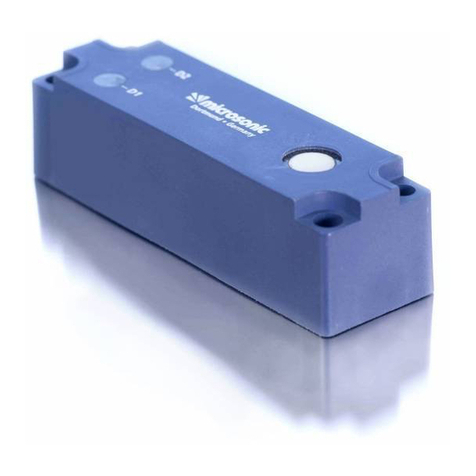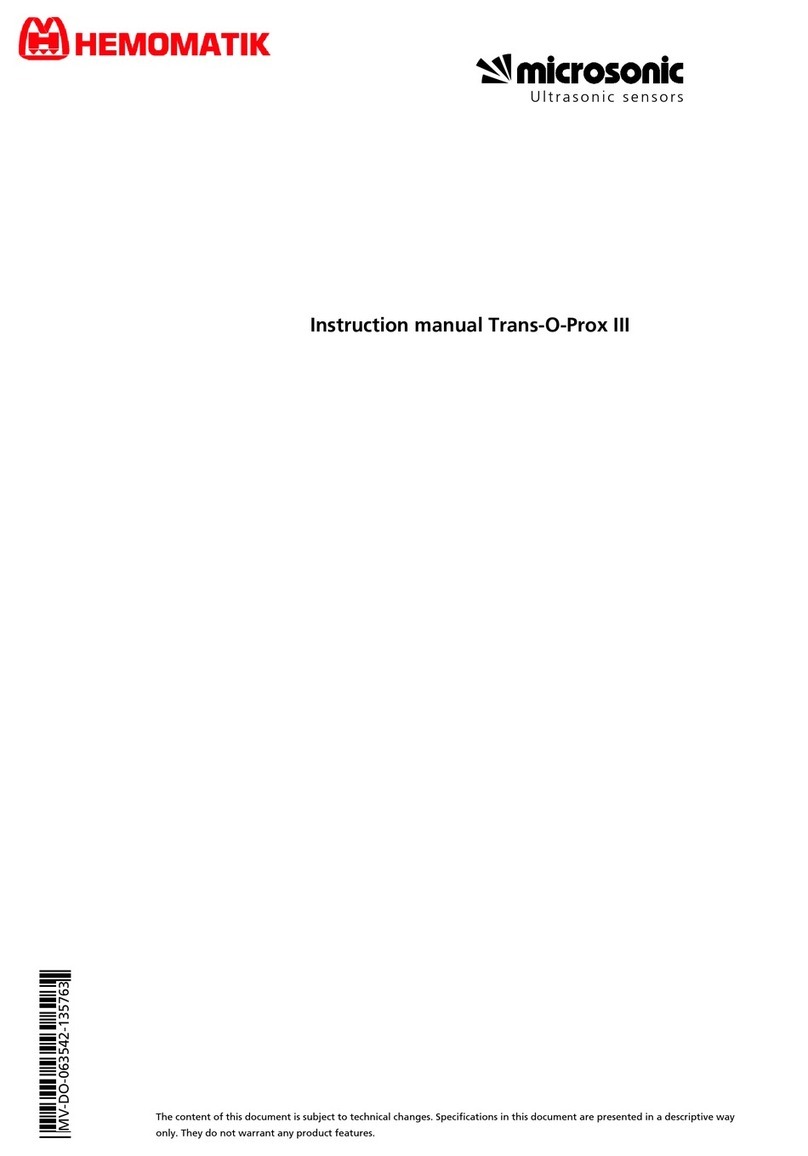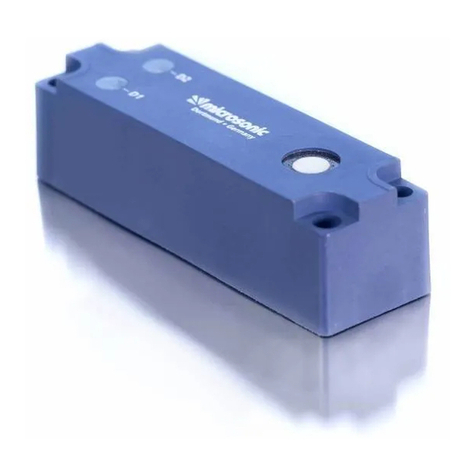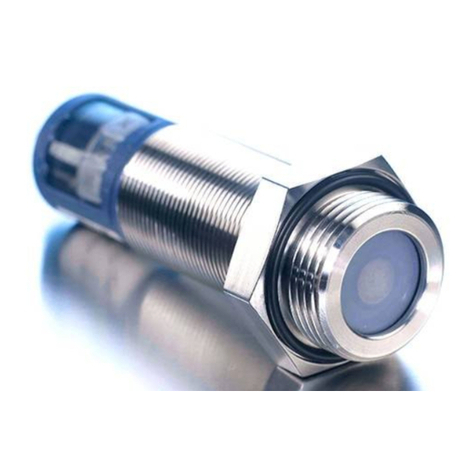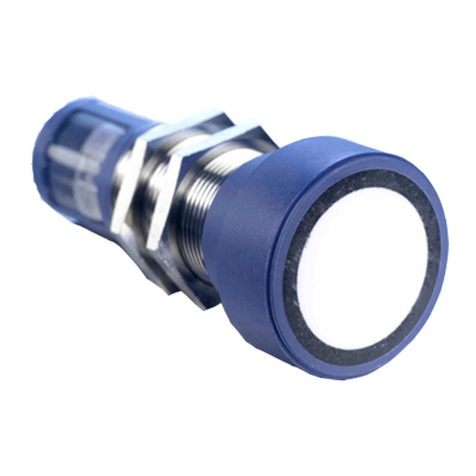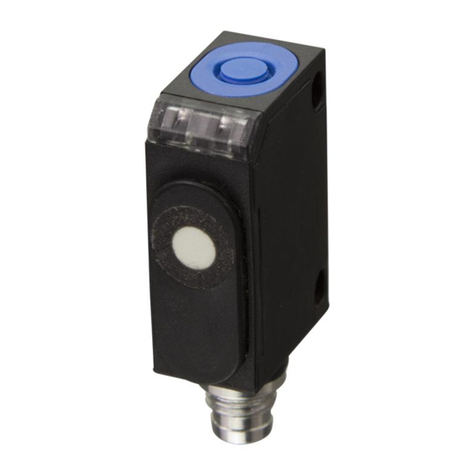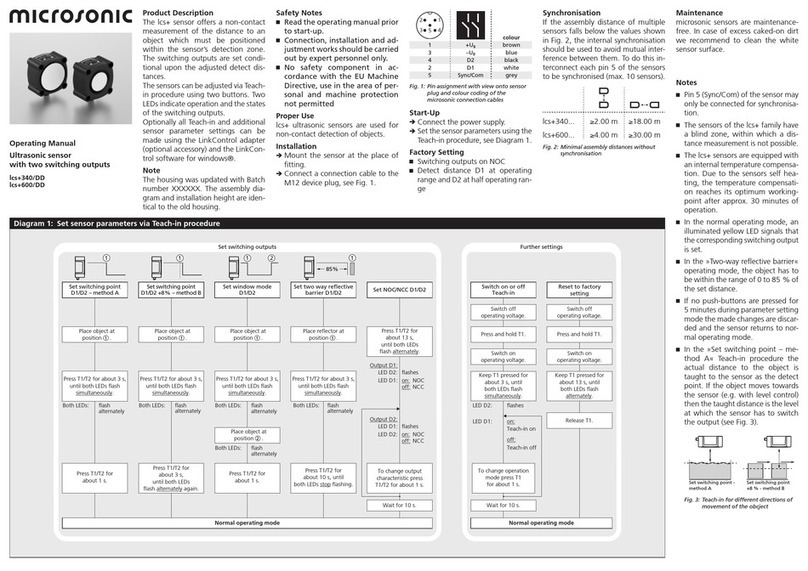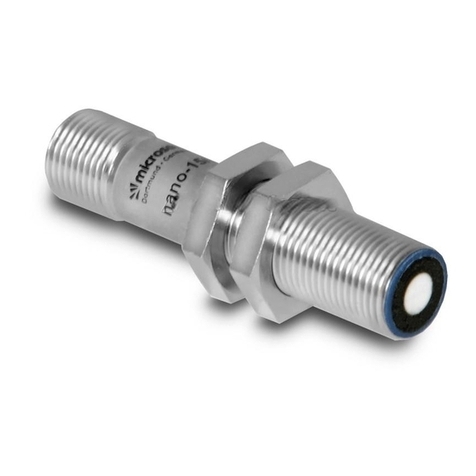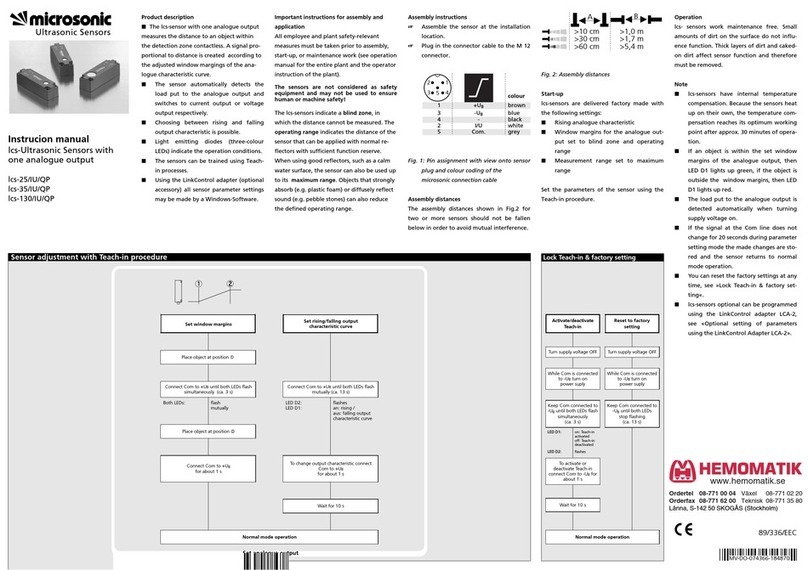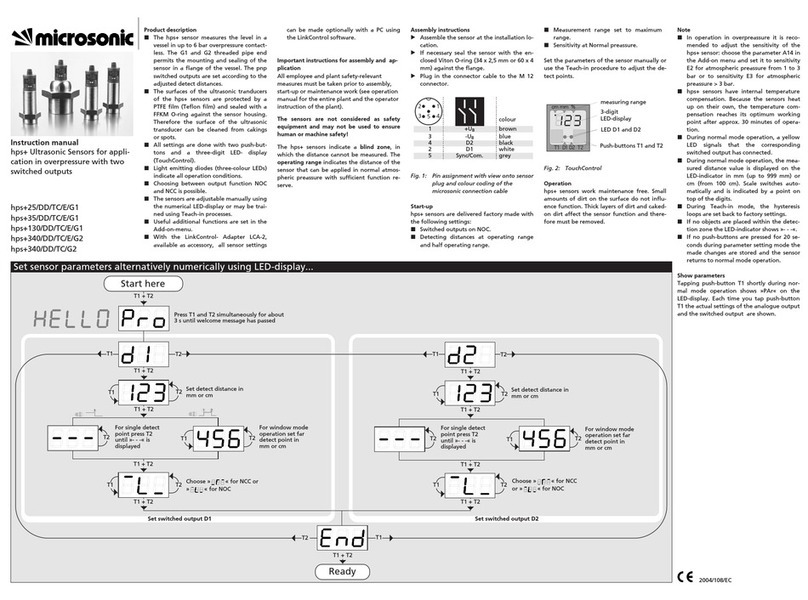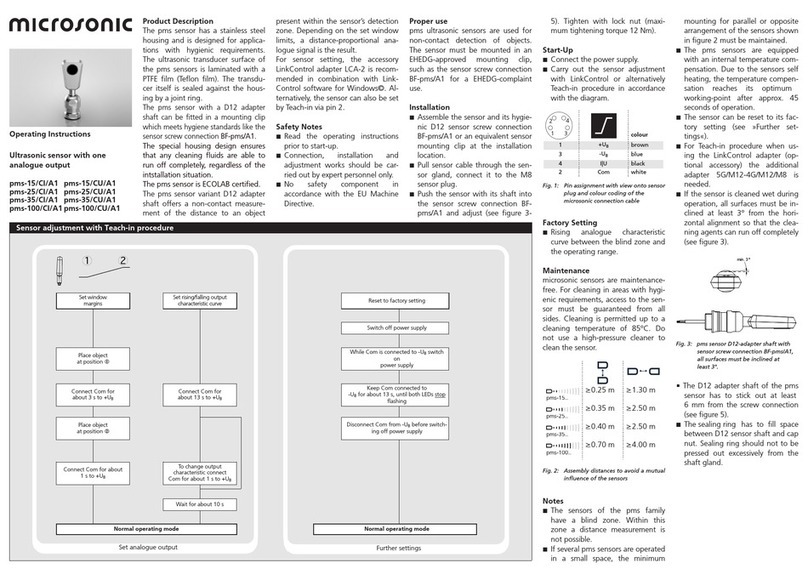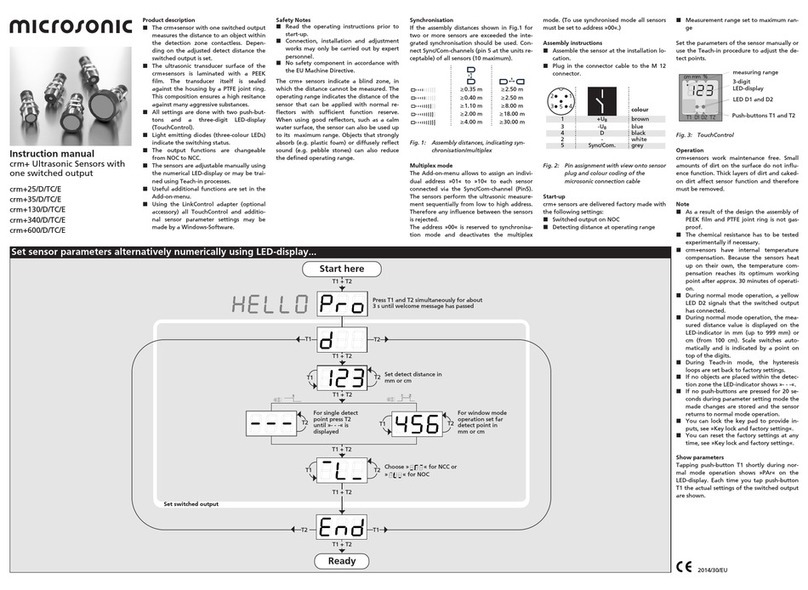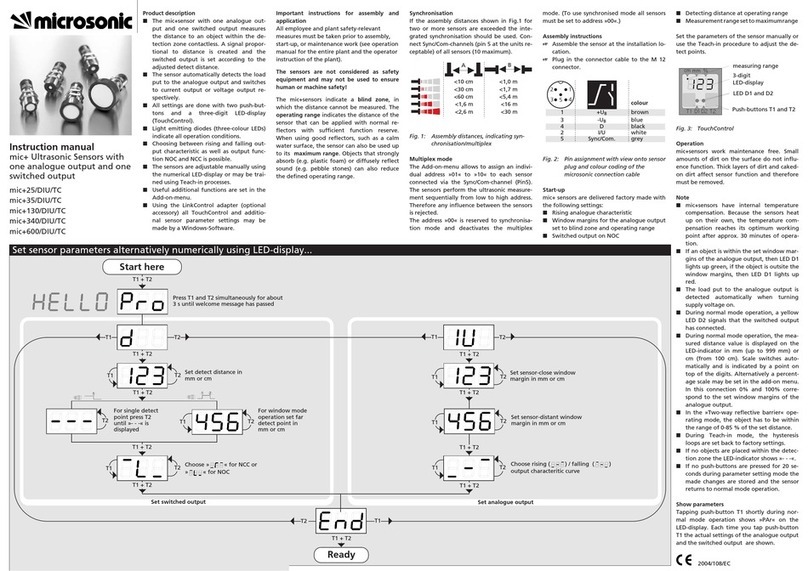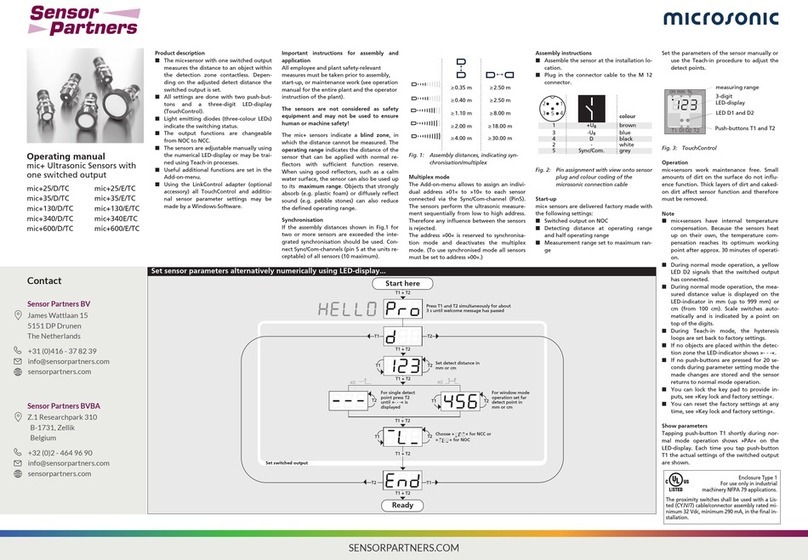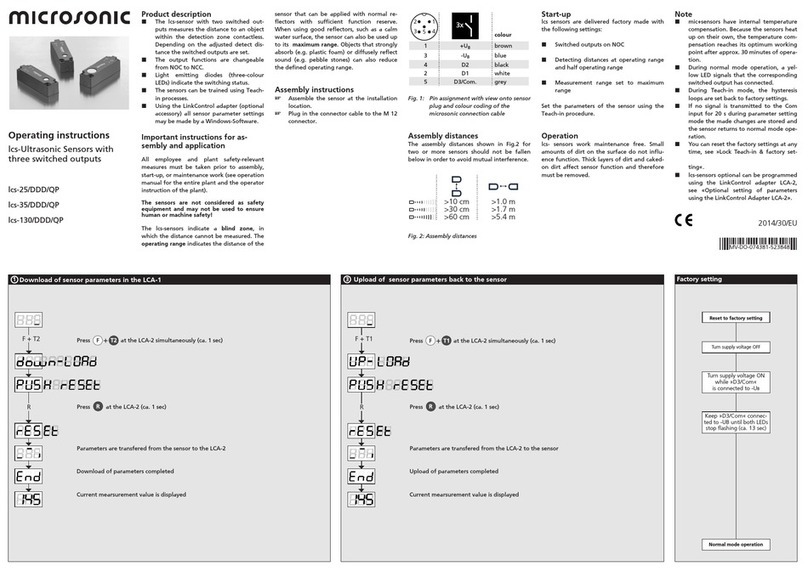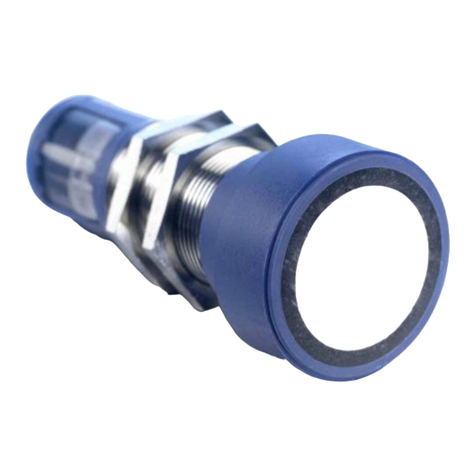
IO-Link mode
IO-Link mode
The pico+ sensors are IO-Link capable
in accordance with IO-Link specifica-
tion V1.0.
Notes
ԎIn IO-Link mode Teach-in, LinkCon-
trol and synchronisation via pin 5
are not available.
ԎIn IO-Link mode, pin 5 must not be
connected to any potential.
Î
For current information about IO-
Link please contact the microsonic
sales department.
Synchronisation in IO-Link mode
In IO-Link mode each sensor is syn-
chronised on the protocol of the IO-
Link master. In multiple sensor opera-
tion the sensors are synchronous if the
master protocols are synchronous.
Process data
The pico+ cyclically transmits the mea-
sured distance value with a resolution
of 0,1 mm and the state of the swit-
ching output.
Service data
The following sensor parameters may
be set via IO-Link interface using the
IO-Link device description (IODD).
Detect point 1
The switching output is activated
when the distance to an object is un-
der that of the present detect point.
Return detect point 1
The switching output is reactivated
when the distance to an object is gre-
ater than the present return detect
point (detect point + hysteresis).
Note
The return detect point 1 must always
be greater than the detect point 1.
Detect point 2, return detect
point 2
By programming these two detect di-
stances the window mode is activated.
Note
The return detect point 2 must always
be smaller than the detect point 2.
ԎF02:
Average value filter, forms the arith-
metic mean across a number of
measurements. The output is acti-
vated in keeping with the average
value. The number of measure-
ments, from which the average va-
lue is formed, depends on the selec-
ted filter strength.
Filter strength
A filter strength between 0 (weak filter
effect) and 9 (pronounced filter effect)
can be selected for each measurement
filter.
Foreground suppression
Spurious reflections, caused by objects
in the foreground of the sensor, may
be blocked out by the foreground sup-
pression.
Notes
Î
Check that the object in the fore-
ground does not cause multiple
reflections.
NOC/NCC operation
The NCC or NOC output function can
be present for the switching output.
Measurement filter
pico+ ultrasonic sensors provide for a
choice of 3 filter settings:
ԎF00:
No filter, each ultrasonic measure-
ment acts in an unfiltered manner
on the output.
ԎF01:
Standard filter, on the object conti-
nuously approaching the sensor, the
ongoing interval is immediately ta-
ken on and the output correspon-
dingly activated. The effect of the
object abruptly moving away from
the sensor is for the existing dis-
tance to be saved for a retaining
time dependent on the filter
strength and for the switching out-
put state to be maintained.
Î
Make sure that the sensor is not
covered by the interfering object to
such an extent that the detection
range is influenced.
System commands
With 4 system commands the fol-
lowing settings may be carried out:
ԎTeach-in detect point – method A
ԎTeach-in detect point – method B
ԎTeach-in two way reflective barrier
ԎReset sensor to factory settings
Notes
To achieve the maximum resolution
the Master Cycle Time has to comply
with the following requirements:
Ԏ
Min Cycle Time ≤Master Cycle
Time ≤Min Cycle Time + 1.2 ms.
Ԏ
If this condition can not be fullfilled,
sporadic discontinuities of the mea-
surement value can occur. In this
case the Master Cycle Time has to
be increased in 400 µs steps until
the discontinuities of the measure-
ment disappear.
Note
If the pico+ sensor was set using
Teach-in or LinkControl it is recom-
mended to reset the sensor to the
factory setting prior to using it in IO-
Link mode (see »Further settings«).
IODD file
ԎThe latest IODD file you will find on
the internet under
www.microsonic.de/en/IODD.
ԎFor further informations on IO-Link
see www.io-link.com.
microsonic
GmbH
/
Phoenixseestraße
7
/
44263
Dortmund
/
Germany
/
T+49 231 975151-0 / F+49 231 975151-51 / E[email protected] / Wmicrosonic.deThe content of this document is subject to technical changes. Specifications in this document are presented in a descriptive way only. They do not warrant any product features.
IO-Link data
pico+15... pico+25... pico+35...
pico+100...
physical layer
SIO mode support yes yes yes yes
min cycle time 8.4 ms 8.4 ms 16 ms 20.4 ms
baud rate COM 2 (38.400 Bd) COM 2 (38.400 Bd) COM 2 (38.400 Bd) COM 2 (38.400 Bd)
format of process data 16 Bit, R, UNI16 16 Bit, R, UNI16 16 Bit, R, UNI16 16 Bit, R, UNI16
content of process data Bit 0: state of switching output; Bit 0: state of switching output; Bit 0: state of switching output; Bit 0: state of switching output;
Bit 1-15: distance value with 0.1 mm resolution Bit 1-15: distance value with 0.1 mm resolution Bit 1-15: distance value with 0.1 mm resolution Bit 1-15: distance value with 0.1 mm resolution
service data IO-Link specific index access value index access value index access value index access value
Vendor name 0x10 R microsonic GmbH 0x10 R microsonic GmbH 0x10 R microsonic GmbH 0x10 R microsonic GmbH
Vendor text 0x11 R www.microsonic.de 0x11 R www.microsonic.de 0x11 R www.microsonic.de 0x11 R www.microsonic.de
Product name 0x12 R pico+ 0x12 R pico+ 0x12 R pico+ 0x12 R pico+
Product ID 0x13 R 15/F;15/WK/F 0X13 R 25/F;25/WK/F 0X13 R 35/F;35/WK/F 0X13 R 100/F;100/WK/F
Product text 0x14 R Ultraschall-Sensor 0x14 R Ultraschall-Sensor 0x14 R Ultraschall-Sensor 0x14 R Ultraschall-Sensor
service data sensor specific index format access range (dez) index format access range (dez) index format access range (dez) index format access range (dez)
detect point 1 0x40 UINT16 R/W 306-3,609 (21-248 mm) 1) 0x40 UINT16 R/W 436-5,065 (30 - 348 mm) 1) 0x40 UINT16 R/W 946-8,704 (65 - 598 mm) 1) 0x40 UINT16 R/W 1,747-18,892 (120 - 1,298 mm) 1)
return detect point 1 0x41 UINT16 R/W 320-3,624 (22-249 mm) 1) 0x41 UINT16 R/W 451-5,080 (31 - 349 mm) 1) 0x41 UINT16 R/W 961-8,718 (66 - 599 mm) 1) 0x41 UINT16 R/W 1,761-18,907 (121 - 1,299 mm) 1)
detect point 2 0x47 UINT16 R/W 335-65,512 (23 - 250 mm) 1) 0x47 UINT16 R/W 466-65,512 (32 - 350 mm) 1) 0x47 UINT16 R/W 975-65,512 (67 - 600 mm) 1) 0x47 UINT16 R/W 1,776-65,512 (122 - 1,300 mm) 1)
> 3,638: window mode deactivated > 5,094: window mode deactivated > 8,733: window mode deactivated > 18,922: window mode deactivated
return detect point 2 0x48 UINT16 R/W 320-65,512 (22 - 250 mm) 1) 0x48 UINT16 R/W 451-65,512 (31 - 349 mm) 1) 0x48 UINT16 R/W 961-65,512 (66 - 599 mm) 1) 0x48 UINT16 R/W 1,761-65,512 (121 - 1,299 mm) 1)
> 3.638: window mode deactivated > 5,094: window mode deactivated > 8,733: window mode deactivated > 18,922: window mode deactivated
switching mode 0x42 UINT8 R/W 00: NCC, 02: NOC 0x42 UINT8 R/W 00: NCC, 02: NOC 0x42 UINT8 R/W 00: NCC, 02: NOC 0x42 UINT8 R/W 00: NCC, 02: NOC
filter 0x43 UINT8 R/W 00-02: F00 - F02 0x43 UINT8 R/W 00-02: F00 - F02 0x43 UINT8 R/W 00-02: F00 - F02 0x43 UINT8 R/W 00-02: F00 - F02
filter strength 0x44 UINT8 R/W 00-09: P00 - P09 0x44 UINT8 R/W 00-09: P00 - P09 0x44 UINT8 R/W 00-09: P00 - P09 0x44 UINT8 R/W 00-09: P00 - P09
foreground suppression 0x49 UINT16 R/W 0-1,878 (0-129 mm) 1) 0x49 UINT16 R/W 0-3,246 (0-223 mm) 1) 0x49 UINT16 R/W 0-4,236 (0-291 mm) 1) 0x49 UINT16 R/W 0-12,969 (0-891 mm) 1)
Teach-in via Pin 5 in SIO mode 0x4A UINT8 R/W 00: deactivated, 16: activated 0x4A UINT8 R/W 00: deactivated, 16: activated 0x4A UINT8 R/W 00: deactivated, 16: activated 0x4A UINT8 R/W 00: deactivated, 16: activated
system commands index access value index access value index access value index access value
Teach-in detect point – method A 0x02 W 161 0x02 W 161 0x02 W 161 0x02 W 161
Teach-in detect point – method B 0x02 W 162 0x02 W 162 0x02 W 162 0x02 W 162
Teach-in two way reflective barrier 0x02 W 164 0x02 W 164 0x02 W 164 0x02 W 164
reset to factory settings 0x02 W 168 0x02 W 168 0x02 W 168 0x02 W 168
1) Distance values, e.g. detect points, are given as multiple of the internal resolution of the measurement value = 0,069 mm (example: 320 ≙22 mm). The values in the table are decimal.
*B10097*MV-DO-153977-785098
